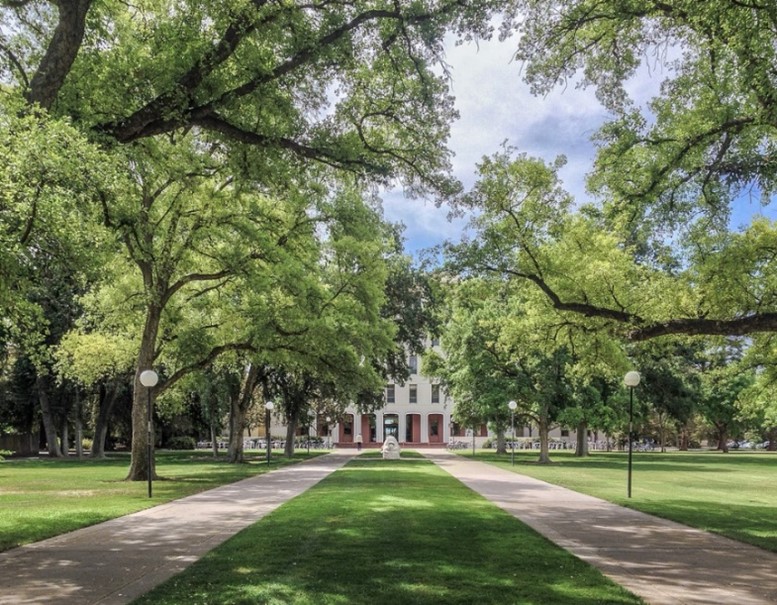By Min Zan
In recent years, the growing concern about climate change and environmental sustainability has prompted institutions worldwide to take action toward creating a greener and more eco-friendly environment. One significant initiative that educational institutions have embraced is the concept of the “Green Campus”. A Green Campus refers to a college or university that prioritizes sustainability, adopting practices and policies that minimize their ecological footprint and promote environmental stewardship. Here, we will delve into the key principles and benefits of a Green Campus, highlighting its importance in shaping a more sustainable future because I heard the word ‘A Green Campus’ which was told by an assistant lecturer while I was in a college 50 years ago and have been interested in it since then.
Key Principles of a Green Campus:
Renewable Energy: One of the primary focuses of a Green Campus is the integration of renewable energy sources, such as solar panels, wind turbines, and geothermal systems. By transitioning away from fossil fuels, educational institutions can significantly reduce their greenhouse gas emissions and contribute to the global effort to combat climate change.
Energy Efficiency: Implementing energy-efficient technologies and practices is another crucial principle of a Green Campus. This involves using LED lighting, optimizing heating and cooling systems, and employing smart building automation to minimize energy waste.
Waste Reduction and Recycling: A Green Campus promotes waste reduction and recycling to divert waste from landfills and conserve resources. By encouraging students and staff to recycle and compost, educational institutions can set an example for responsible waste management.
Sustainable Transport: Green Campuses advocate for sustainable transportation options, such as promoting walking, biking, and public transport, as well as providing charging stations for electric vehicles. These campuses aim to decrease carbon emissions and air pollution by reducing reliance on gas-powered vehicles.
Green Spaces and Biodiversity: Creating and maintaining green spaces on campus fosters biodiversity and improves overall ecological health. Planting native species, establishing gardens, and preserving natural habitats contribute to a more sustainable environment and provide valuable learning opportunities.
Water Conservation: Encouraging water-saving practices, such as using low-flow fixtures and capturing rainwater for irrigation, is essential to a Green Campus. Water conservation helps preserve this valuable resource and reduces the institution’s impact on local water systems.
Environmental Education and Research: A Green Campus serves as a platform for environmental education and research. By incorporating sustainability into the curriculum and conducting relevant research, these institutions equip students with the knowledge and skills to become environmentally conscious global citizens.
Benefits of a Green Campus: A green campus, also known as a sustainable or eco-friendly campus, refers to an educational institution that incorporates environmentally friendly practices and promotes sustainability in various aspects of its operations. Green campuses offer numerous benefits, not only for the environment but also for the students, staff, and surrounding community. Now, let me present some of the key advantages of having a green campus:
Environmental preservation: Green campuses strive to reduce their ecological footprint and promote the conservation of natural resources. They often implement energy-efficient practices, waste reduction strategies, and sustainable landscaping, which collectively contribute to protecting the environment.
Reduced carbon emissions: By adopting renewable energy sources, energy-efficient buildings, and promoting sustainable transport options, green campuses can significantly reduce carbon emissions, helping combat climate change.
Cost savings: Sustainable practices such as energy conservation, waste reduction, and water efficiency can lead to cost savings for the institution. Investing in energy-efficient technologies and renewable energy sources can lower utility bills over time, freeing up resources for other campus initiatives.
Health and well-being: A green campus can create a healthier and more pleasant environment for everyone. Better indoor air quality, natural lighting, and access to green spaces have been linked to improved mental and physical well-being.
Educational opportunities: Green campuses offer unique learning experiences and opportunities for students to engage with sustainability initiatives. Hands-on involvement in environmental projects fosters a sense of responsibility and empowers students to become environmentally conscious citizens.
Community engagement: A green campus can serve as a hub for sustainability activities within the local community. By hosting workshops, events, and outreach programmes, the campus can inspire and educate the surrounding community about sustainable practices.
Positive reputation: Adopting sustainable practices enhances the institution’s reputation and demonstrates its commitment to environmental stewardship. It can attract environmentally-conscious students, faculty, donors or town elders who prioritize sustainability in their decision-making.
Resilience to climate change: Green campuses often incorporate climate-resilient infrastructure and practices that can better withstand the impacts of extreme weather events and changing climate patterns.
Innovation and research: Sustainable campuses often provide opportunities for research and innovation in the field of sustainability. This can lead to the development of new technologies and practices that contribute to broader environmental solutions.
Leadership example: Green campuses can become leaders in sustainability, influencing other institutions and inspiring them to adopt eco-friendly practices. They can act as models for responsible environmental practices across the education sector.
What’s more, a green campus not only contributes to a healthier planet but also provides numerous benefits to its occupants and the community at large. By integrating sustainable practices into their daily operations, educational institutions can play a vital role in promoting environmental consciousness and responsible stewardship among the students and staff.
Designing the Green Campus
As the world grapples with the pressing challenges of climate change and environmental degradation, sustainable practices have become a necessity in all aspects of life. Higher education institutions, as centers of learning and innovation, have a crucial role to play in promoting sustainability. “Green campuses” are essential to mitigating environmental impacts and fostering a culture of environmental responsibility among respective personnel. Now, we again explore the concept of designing a green campus, highlighting key principles, strategies, and benefits.
Understanding Green Campus Design
Green campus design goes beyond incorporating a few solar panels or recycling bins mentioned earlier. It is an integrated approach that aims to create sustainable, resource-efficient, and environmentally friendly campuses. The design process must consider various factors, including energy efficiency, water conservation, waste management, transportation, landscaping, and building materials.
Sustainable Infrastructure and Buildings
A critical aspect of designing a green campus is constructing sustainable buildings. This involves utilizing eco-friendly building materials, adopting energy-efficient designs, and incorporating renewable energy sources. Green buildings may include features such as passive solar design, proper insulation, energy-efficient lighting, and smart building automation systems.
Energy Efficiency
Higher education institutions consume substantial energy resources, but there are ways to reduce this impact. Implementing energy-efficient practices like LED lighting, motion sensors, and energy-efficient HVAC (Heating, Ventilation And Air Conditioning) systems can significantly lower energy consumption and greenhouse gas emissions.
Water Conservation
Water scarcity is a growing concern, making water conservation a key element of green campus design. Campuses can adopt water-efficient fixtures, rainwater harvesting systems, and low-impact landscaping to minimize water usage.
Waste Management and Recycling
Efficient waste management and recycling systems are vital to reduce the environmental footprint of a campus. Implementing recycling programs, composting organic waste, and reducing single-use plastics are effective strategies.
Sustainable Transportation
Encouraging sustainable transportation options can significantly impact the carbon footprint of a campus. Providing bike-sharing programmes, promoting public transportation use, and offering electric vehicle charging stations are effective ways to promote greener commuting.
Green Spaces and Landscaping
Creating green spaces and maintaining natural landscapes on campus can enhance biodiversity and improve the overall well-being of students and staff. Native plantings, green roofs, and urban gardens can contribute to a healthier and more sustainable environment.
Education and Outreach
In addition to physical changes, educational initiatives are crucial for fostering a culture of sustainability. Campuses can integrate sustainability into their curricula, host workshops and seminars on environmental topics, and encourage student-led sustainability projects.
Designing a green campus offers numerous advantages. These benefits include reduced environmental impact, lower operating costs through energy and resource efficiency, improved health and well-being of the campus community, enhanced reputation and attractiveness to prospective students and faculty, and contribution to the broader global sustainability goals.
Moreover, it is also a complex process that requires careful consideration of a variety of factors. From choosing sustainable materials for construction to implementing energy-efficient technologies, there are many ways to create an environmentally friendly campus.
One important aspect of designing a green campus is choosing low-impact materials for construction. This can include using recycled materials, such as reclaimed wood or recycled concrete, as well as choosing materials with a low carbon footprint, such as bamboo or hemp.
Another important consideration is energy efficiency. Implementing technologies such as solar panels, energy-efficient lighting, and smart building systems can help reduce energy consumption on campus and lower carbon emissions.
In addition to these measures, designing a green campus also involves creating a culture of sustainability among students, faculty, staff, and every educated person. This can include initiatives such as composting programmes, bike-sharing programs, and education campaigns to promote sustainable behaviours.
In brief, designing a green campus is not just an option; it is an ethical responsibility of higher education institutions. By adopting sustainable practices in campus design, universities, and colleges can lead by example, inspiring future generations to become environmentally conscious and proactive global citizens. As the world faces unprecedented environmental challenges, green campuses serve as beacons of hope, fostering a brighter and greener future for all, I assume.
Reference:
Designing the Campus of the Future: Sustainable and Innovative Approaches

















